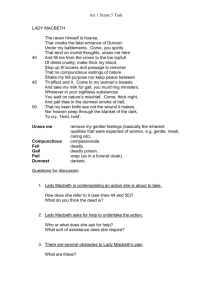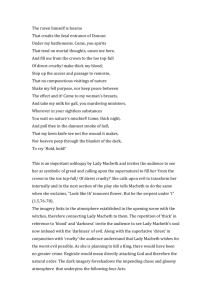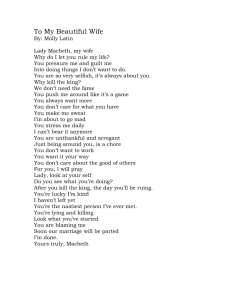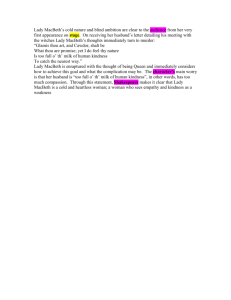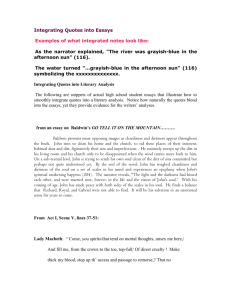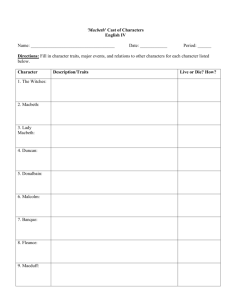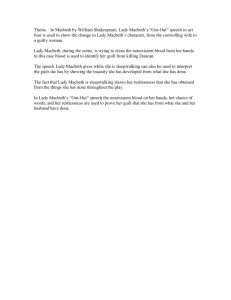Quotations & Referencing Guide: MLA Style
advertisement
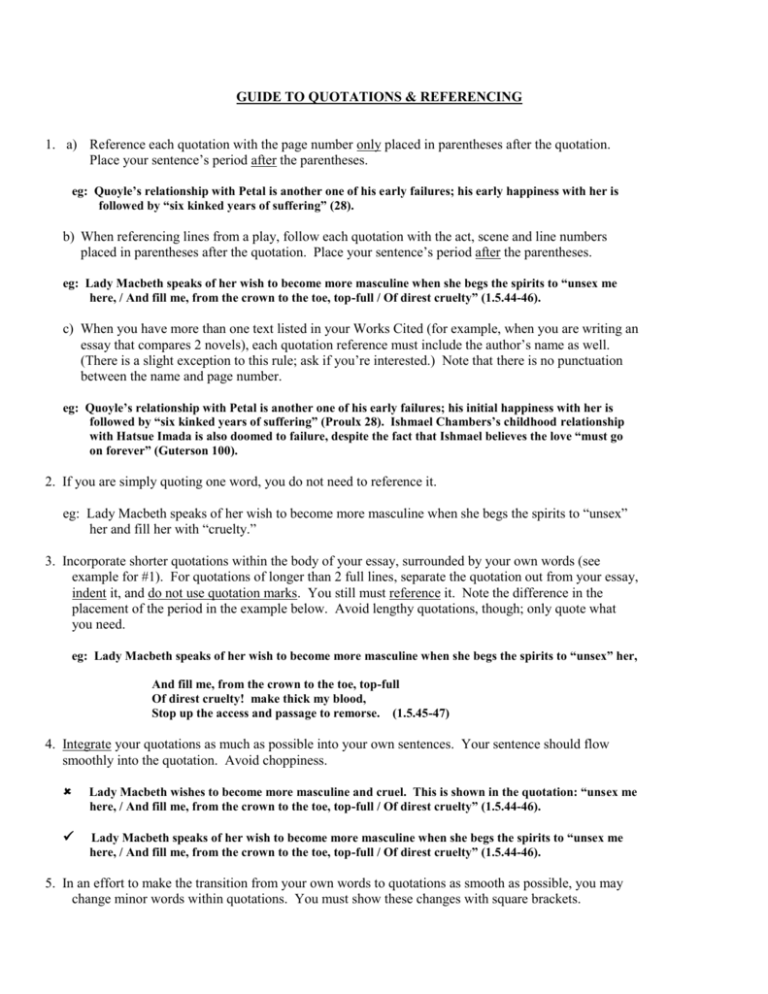
GUIDE TO QUOTATIONS & REFERENCING 1. a) Reference each quotation with the page number only placed in parentheses after the quotation. Place your sentence’s period after the parentheses. eg: Quoyle’s relationship with Petal is another one of his early failures; his early happiness with her is followed by “six kinked years of suffering” (28). b) When referencing lines from a play, follow each quotation with the act, scene and line numbers placed in parentheses after the quotation. Place your sentence’s period after the parentheses. eg: Lady Macbeth speaks of her wish to become more masculine when she begs the spirits to “unsex me here, / And fill me, from the crown to the toe, top-full / Of direst cruelty” (1.5.44-46). c) When you have more than one text listed in your Works Cited (for example, when you are writing an essay that compares 2 novels), each quotation reference must include the author’s name as well. (There is a slight exception to this rule; ask if you’re interested.) Note that there is no punctuation between the name and page number. eg: Quoyle’s relationship with Petal is another one of his early failures; his initial happiness with her is followed by “six kinked years of suffering” (Proulx 28). Ishmael Chambers’s childhood relationship with Hatsue Imada is also doomed to failure, despite the fact that Ishmael believes the love “must go on forever” (Guterson 100). 2. If you are simply quoting one word, you do not need to reference it. eg: Lady Macbeth speaks of her wish to become more masculine when she begs the spirits to “unsex” her and fill her with “cruelty.” 3. Incorporate shorter quotations within the body of your essay, surrounded by your own words (see example for #1). For quotations of longer than 2 full lines, separate the quotation out from your essay, indent it, and do not use quotation marks. You still must reference it. Note the difference in the placement of the period in the example below. Avoid lengthy quotations, though; only quote what you need. eg: Lady Macbeth speaks of her wish to become more masculine when she begs the spirits to “unsex” her, And fill me, from the crown to the toe, top-full Of direst cruelty! make thick my blood, Stop up the access and passage to remorse. (1.5.45-47) 4. Integrate your quotations as much as possible into your own sentences. Your sentence should flow smoothly into the quotation. Avoid choppiness. Lady Macbeth wishes to become more masculine and cruel. This is shown in the quotation: “unsex me here, / And fill me, from the crown to the toe, top-full / Of direst cruelty” (1.5.44-46). Lady Macbeth speaks of her wish to become more masculine when she begs the spirits to “unsex me here, / And fill me, from the crown to the toe, top-full / Of direst cruelty” (1.5.44-46). 5. In an effort to make the transition from your own words to quotations as smooth as possible, you may change minor words within quotations. You must show these changes with square brackets. 2 eg: Lady Macbeth speaks of her wish to become more masculine when she begs the spirits to “unsex [her] here, / And fill [her], from the crown to the toe, top-full / Of direst cruelty” (1.5.44-46). 6. Be sure to use proper punctuation when introducing your quotation. Choose from the options below: a. If there is no pause required between your own words and the quotation, you do not need to use punctuation at all. eg: Lady Macbeth begs the spirits to “unsex [her] here” (1.5.44). b. If a pause is required, and the introducing sentence is a full/complete sentence, use a colon. eg: After reading her husband’s letter, Lady Macbeth speaks of her wish to become more masculine: “Come, you spirits / …unsex me here” (1.5.44). c. If a pause is required, and the introducing sentence is not a full/complete sentence, use a comma. eg. Lady Macbeth begs the spirits to “unsex” her, “[a]nd fill [her]…top-full / (1.5.45-46). Of direst cruelty” 7. If you wish to remove parts of quotations that you do not need to make your point, you may do so, but must show the omitted portion with ellipses (three periods). eg: Lady Macbeth speaks of her wish to become more masculine when she begs the spirits to “unsex me here, / And fill me…top-full / Of direst cruelty” (1.5.44-46). Note that this is the only time you need ellipses. You do not need ellipses at the beginning of a quotation, even if you have started quoting mid-sentence. You do not need ellipses at the end of a quotation either, even if you have cut the quotation off before the end of a sentence. Lady Macbeth speaks of her wish to become more masculine when she begs the spirits to “…unsex me here…” (1.5.44). 8. When quoting dialogue, place your quotation in double quotation marks (“) and the dialogue in single quotation marks (‘). eg: On Gaze Island, Quoyle learns the reason behind Billy Pretty’s bachelorhood: “‘Between you and me,’ said Billy, ‘I had a personal affliction and didn’t want anybody to know’” (192). 9. When quoting words from a play that are already in quotation marks, use single quotation marks. eg: 2.2.47-48 becomes: I heard a voice cry, “Sleep no more! / Macbeth does murder sleep” “I heard a voice cry, ‘Sleep no more! / Macbeth does murder sleep’” 10. When you are quoting poetic lines from a play (as opposed to prose lines), you must show the line breaks with a backslash. eg: Lady Macbeth speaks of her wish to become more masculine when she begs the spirits to “unsex me here, / And fill me, from the crown to the toe, top-full / Of direst cruelty” (1.5.44-46). 3 WORKS CITED You must include a Works Cited page with a literary essay. Please note the examples below: the punctuation, italicization, spacing and indentation of the second line. Bibliographic entries for sources such as short stories, poems, anthologies, newspapers, etc. have slightly different formats. Refer to the MLA Handbook, or Joanne Buckley’s Fit to Print for guidance. Ask your teacher if you need clarification. MLA 2009 Sample Entries Before the MLA Handbook for Writers of Research Papers (7th edition) arrives, refer to the following preview. Each entry highlights changes in the new edition. Book Book citations remain largely the same except for the addition of the medium of publication, Print, at the end of the entry. Carré, John le. The Tailor of Panama. New York: Alfred A. Knopf, 1996. Print. Scholarly Publication (Journal) Regardless of pagination, all scholarly publication citations include both volume and issue numbers. End citations with the medium of publication, Print. Aldrich, Frederick A. and Margueritte L. Marks. “Wyman Reed Green, American Biologist.” Bios 23.1 (1952): 26-35. Print. Online Periodical Online periodicals include both the name of the website in italics and the website publisher. Note that some sites will have different names than their print formats, such as ones that include a domain name like .com or .org. If no publisher is listed, use N.p. to denote no publisher name given. Follow with date of publication, Web as medium of publication, and date of access. Lubell, Sam. “Of the Sea and Air and Sky.” New York Times. New York Times, 26 Nov. 2008. Web. 1 Dec. 2008. Online Database Scholarly Journal Article Cite online journal articles from an online database as you would a print one. Provide the database name in italics. Library information is no longer required. List the medium of publication as Web and end with the date of access. Berger, James D. and Helmut J. Schmidt. “Regulation of Macronuclear DNA Content in Paramecium Tetraurelia.” The Journal of Cell Biology 76.1 (1978): 116-126. JSTOR. Web. 20 Nov. 2008. Online-only Publication For articles that appear in an online-only format or in databases that do not provide a page number, use the abbreviation n. pag. for no pagination. End the citation with the medium of publication, Web, and the date of access. Kessl, Fabian, and Nadia Kutsche. “Rationalities, Practices, and Resistance in Post-Welfarism. A Comment on Kevin Stenson.” Social Work & Society 6.1 (2008): n. pag. Web. 10 Oct. 2008. 4 A 2 source works cited page would look like this: Works Cited Carré, John le. The Tailor of Panama. New York: Alfred A. Knopf, 1996. Print. Kessl, Fabian, and Nadia Kutsche. “Rationalities, Practices, and Resistance in Post Welfarism. A Comment on Kevin Stenson.” Social Work & Society 6.1 (2008): n. pag. Web. 10 Oct. 2008.
